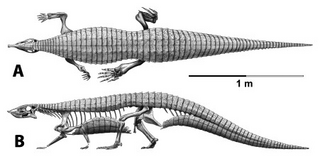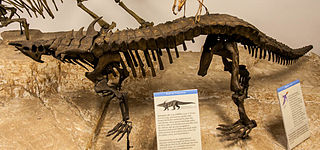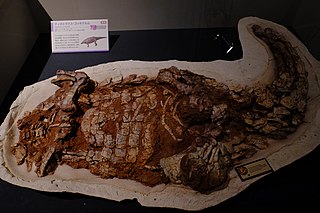
Aetosaurs are heavily armored reptiles belonging to the extinct order Aetosauria. They were medium- to large-sized omnivorous or herbivorous pseudosuchians, part of the branch of archosaurs more closely related to crocodilians than to birds and other dinosaurs. All known aetosaurs are restricted to the Late Triassic, and in some strata from this time they are among the most abundant fossil vertebrates. They have small heads, upturned snouts, erect limbs, and a body ornamented with four rows of plate-like osteoderms. Aetosaur fossil remains are known from Europe, North and South America, parts of Africa, and India. Since their armoured plates are often preserved and are abundant in certain localities, aetosaurs serve as important Late Triassic tetrapod index fossils. Many aetosaurs had wide geographic ranges, but their stratigraphic ranges were relatively short. Therefore, the presence of particular aetosaurs can accurately date a site in which they are found.

Revueltosaurus is an extinct genus of suchian pseudosuchian from Late Triassic deposits of New Mexico, Arizona and North Carolina, United States. Many specimens, mostly teeth, have been assigned to Revueltosaurus over the years. Currently, three species are included in this genus, all of which were originally thought to represent monospecific genera of basal ornithischian dinosaurs. Revueltosaurus was about 1 meter long.

Stagonolepis is an extinct genus of stagonolepidid aetosaur known from the Late Triassic Hassberge Formation of Germany, the Drawno Beds of Poland, and the Lossiemouth Sandstone of Scotland. Supposed fossils from North and South America have been placed into their own genera, Calyptosuchus and Aetosauroides, respectively.

Desmatosuchus is an extinct genus of archosaur belonging to the Order Aetosauria. It lived during the Late Triassic.
Calyptosuchus is an extinct genus of aetosaur from the Late Triassic of North America. Like other aetosaurs, it was heavily armored and had a pig-like snout used to uproot plants.

Acaenasuchus is an extinct genus of pseudosuchian, endemic to what would be presently be known as Arizona during the Late Triassic, specifically during the Carnian and Norian stages of the Triassic. Acaenasuchus had a stratigraphic range of approximately 11.5 million years. Acaenasuchus is further categorized as one of the type fauna that belong to the Adamanian LVF, based on the fauna of the Blue Mesa Member of the Chinle Petrified Forest Formation of Arizona, where Acaenasuchus was initially discovered.

Typothorax is an extinct genus of typothoracine aetosaur that lived in the Late Triassic. Its remains have been found in North America. Two species are known: T. coccinarum, the type species, and T. antiquum.
Lucasuchus is an extinct genus of aetosaur. Fossils have been found from the Bull Canyon Formation of the Dockum Group outcropping in the Revuelto Creek locality in Quay County, New Mexico. All specimens date back to the Norian stage of the Late Triassic. The genus was named in 1995 after the American paleontologist Spencer G. Lucas.

Machaeroprosopus is an extinct genus of mystriosuchin leptosuchomorph phytosaur from the Late Triassic of the southwestern United States. M. validus, once thought to be the type species of Machaeroprosopus, was named in 1916 on the basis of three complete skulls from Chinle Formation, Arizona. The skulls have been lost since the 1950s, and a line drawing in the original 1916 description is the only visual record of the specimen. Another species, M. andersoni, was named in 1922 from New Mexico, and the species M. adamanensis, M. gregorii, M. lithodendrorum, M. tenuis, and M. zunii were named in 1930. Most species have been reassigned to the genera Smilosuchus, Rutiodon, or Phytosaurus. Until recently, M. validus was considered to be the only species that has not been reassigned. Thus, Machaeroprosopus was considered to be a nomen dubium or "doubtful name" because of the lack of diagnostic specimens that can support its distinction from other phytosaur genera. However, a taxonomic revision of Machaeroprosopus, conducted by Parker et al. in 2013, revealed that UW 3807, the holotype of M. validus, is not the holotype of Machaeroprosopus, while the species Machaeroprosopus buceros, Machaeroprosopus being a replacement name, with a fixed type species, for Metarhinus, is the combinatio nova of the type species of the genu: Belodon buceros. Therefore, the name Pseudopalatus must be considered a junior synonym of Machaeroprosopus, and all species of the former must be reassigned to the latter. This revised taxonomy was already accepted in several studies, including Stocker and Butler (2013). Stocker and Butler (2013) also treated M. andersoni as a valid species, and not a junior synonym of Machaeroprosopus buceros as was previously suggested by Long and Murry (1995).

Paratypothorax is an extinct genus of aetosaur, known from a single species, Paratypothorax andressorum. It was a broadly distributed member of the group found in Germany, North America, and possibly parts of Gondwana. The best specimens come from Germany, though for more than a century they were mistakenly considered phytosaur armor. Paratypothorax was a large and wide-bodied typothoracine aetosaur, as well as the namesake of the tribe Paratypothoracisini.
Tecovasuchus is an extinct genus of aetosaur. It is known primarily from osteoderms found from the Tecovas Formation in Texas, which is Late Triassic in age, dating back to the lower Norian. Material is also known from several other localities of the Chinle Group in New Mexico and Arizona, such as older Carnian outcrops and younger Rhaetian outcrops. Specimens of Tecovasuchus have been collected from the Tecovas Formation, the Bluewater Creek Formation, and the Los Esteros Member of the Santa Rosa Formation.

Aetosaurinae is one of the two main clades of aetosaurs, the other being Desmatosuchia. It is a stem-based taxon defined as all aetosaurs more closely related to Aetosaurus than Desmatosuchus. Aetosaurinae currently comprises Aetosaurus, similar forms such as Coahomasuchus and Stenomyti, and the widespread and successful aetosaur clade Typothoracinae.
Redondasuchus is an extinct genus of aetosaur. It may be a junior synonym of Typothorax coccinarum, another aetosaur. Redondasuchus is a member of the clade Typothoracisinae within the subfamily Aetosaurinae, and lived during the middle Norian stage of the Late Triassic. Material belonging to the genus has been found from the Redonda Formation in east-central New Mexico. The type species, R. reseri, was named in 1991 after having been referred to as a species of Typothorax since 1985. A second species, R. rineharti, was described in 2006.
Acallosuchus is an extinct genus of reptile from the Triassic Chinle Formation of the southwestern United States. Although it was discovered in 1923, Acallosuchus was not described until 1995, when the type species A. rectori was named. The taxonomy classification of Acallosuchus is uncertain. Although it is known to be a neodiapsid reptile, it has not been assigned with confidence to any particular group of neodiapsids.
Gorgetosuchus is an extinct genus of aetosaur from the Late Triassic of the North Carolina, represented by the type species Gorgetosuchus pekinensis. It is mainly known from osteoderms, including the front half of an articulated carapace. Gorgotesuchus is typically considered a basal desmatosuchin, though alternative interpretations exist.

Scutarx is an extinct genus of Aetosauriformes, most commonly regarded by its species name Scutarx deltatylus. Scutarx lived around 230 million years ago during the Carnian and Norian stage of the Late Triassic. Scutarx are “medium sized” paramedian osteoderms belonging to the clade Aetosauria, a heavily armored and more herbivorous cousin of crocodiles.
Land vertebrate faunachrons (LVFs) are biochronological units used to correlate and date terrestrial sediments and fossils based on their tetrapod faunas. First formulated on a global scale by Spencer G. Lucas in 1998, LVFs are primarily used within the Triassic Period, though Lucas later designated LVFs for other periods as well. Eight worldwide LVFs are defined for the Triassic. The first two earliest Triassic LVFs, the Lootsbergian and Nonesian, are based on South African synapsids and faunal assemblage zones estimated to correspond to the Early Triassic. These are followed by the Perovkan and Berdyankian, based on temnospondyl amphibians and Russian assemblages estimated to be from the Middle Triassic. The youngest four Triassic LVFs, the Otischalkian, Adamanian, Revueltian, and Apachean, are based on aetosaur and phytosaur reptiles common in the Late Triassic of the southwestern United States.
Venkatasuchus is an extinct genus of aetosaur from the Late Triassic Dharmaram Formation of India. It was described in 2023 on the basis of a series of associated osteoderms that formed the paramedian and lateral armour. Based on the osteoderms the carapace of Venkatasuchus was disc-shaped and very wide, with curved, horn-like elements along its sides. Phylogenetic analysis indicates that Venkatasuchus belonged to the subfamily Typothoracinae and more specifically the clade Paratypothoracini, where it is recovered as the sister taxon to Kocurypelta. Venkatasuchus is among the few aetosaurs recovered from the region that would later become Gondwana and lends credence to the idea that late Triassic India represented a connective hub between Laurasian and Gondwanan fauna. The genus is monotypic, meaning it only includes a single species, Venkatasuchus armatum.
Garzapelta is an extinct genus of aetosaur from the Late Triassic Cooper Canyon Formation containing a single species, G. muelleri. Garzapelta is known primarily from an associated collection of osteoderms, although some other bones such as ribs are also known. The anatomy of Garzapelta's armour displays a mix of features otherwise seen in Rioarribasuchus chamaensis, a member of the Paratypothoracini, and taxa of the subfamily Desmatosuchinae. This mix of characters is so distinct that phylogenetic analysis yielded different results based on what parts of the osteoderms were used, suggesting that the current dataset does not account for convergent evolution in osteoderm anatomy. Reyes, Martz and Small suggest that Garzapelta was likely a paratypothoracin that simply evolved lateral osteoderms similar to those of desmatosuchins, reasoning that its armour does not articulate in the way seen in members of the latter group.









